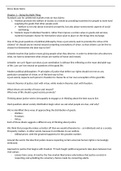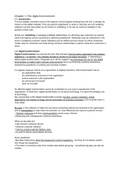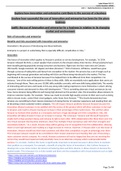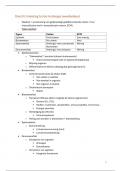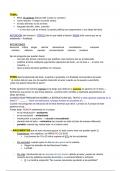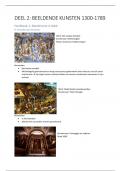Reporting:
- Percentages: one decimal; p-values three decimals; any other: two
decimals
- Check the italic (P, sd, t, f)
- When a p value is below .001, report it in the following manner: p < .001.
Table of Contents
Bivariate analysis: analysis of two variables............................................................................2
PEARSON’S CHI SQUARE........................................................................................................................ 2
PEARSON’S R............................................................................................................................................. 4
Compare Means - t-test......................................................................................................................9
Independent sample t-test................................................................................................................... 9
Dependent (paired) sample t-test................................................................................................... 11
One sample t-test.................................................................................................................................. 12
One -way Anova.................................................................................................................................13
Factorial Anova..................................................................................................................................15
Simple regression analysis............................................................................................................18
Multiple regression..........................................................................................................................21
CREATING DUMMY VARIABLES.....................................................................................................24
INTERACTION BETWEEN TWO VARIABLES..............................................................................25
Factor analysis...................................................................................................................................27
, Bivariate analysis: analysis of two variables
Step 1: Define measurement level
Step 2: Define whether the relationship is symmetric or asymmetric
- Symmetric: no dependent variable
- Merely association
- We don’t know whether variable A affects variable B or whether B
affects A but we know that A and B tend to go together.
- Asymmetric: independent and dependent variable
- One variable affects the other variable
- The independent variable affects the dependent variable
Step 3: Choose the right test of significance and its associated effect size
PEARSON’S CHI SQUARE
Since we have two categorical variables, we should in this case run Pearson’s chi
square followed by _____ test of association.
NOMINAL ORDINAL VARIABLES (IS THERE A RELATIONSHIP BTW TWO
CATEGORICAL VARIABLES)
Null hypothesis that there is no association between [variable1] and [variable2] in
the population.
ASSUMPTIONS
- At least 80% of cells of the contingency table have an expected frequency
(expected count) of 5;
- No cells (0%) have an expected frequency of 0;
- The contingency table has at least 3 columns or 3 rows.
(IF NO LOOK AT FISHER EXACT)**
“0 cells (0.0%) have expected count less than 5. The minimum expected count is
11.60,” so these conditions are met. Furthermore, since this is a 4-by-2 table, we
satisfy the condition relative to the minimum number of columns or rows as well.”
If assumptions are met: run the chi-square:
To run a Chi-square analysis (CHECK ASSUMPTIONS)
- Analyse
- Descriptive Statistics
- Crosstabs
- Insert
- Independent variable in the columns
- Dependent variable in the rows
- Then you check the
- Cells: Counts – click “observed” and “expected”
Percentage – click “columns”
- Statistics: Click “Chi-square” and select the appropriate test (see
table below), “Goodman & Kruskall’sTau” = “lambda”.
- Then Paste
, - Run
NB: a strong association that is not statistically significant will still be
redeemed as no association in the population.
**If the contingency table does not have more than 2 rows or columns?
Fisher Exact
To run a Fisher Exact analysis
- Click on Analyze -> Descriptive Statistics -> Crosstabs
- Insert
- Independent variable in the columns
- Dependent variable in the rows
- Click on Statistics,
- select Chi-square,
- Select your test
- and then click on Continue
- Click on Exact, and then select the Exact option, leaving the test time limit
as it is
- Press Continue, and then OK to run the test
- The result will appear in the SPSS output viewer
We report the results of the Fisher Exact test in a slightly different manner.
Only report the exact p-value, which we find in the “Fisher Exact Test”, “Two-
sided” row of the “Chi-Square Test” table in the SPSS output.
“(There is a / there is no ) statistically significant (causal) relationship
between [variable1] and [variable2], p = xxx (Fisher Exact).”
, PEARSON’S R
Since we have two continuous variables with a symmetric relationship, we should
in this case run Pearson’s R.
INTERVAL/RATIO VARIABLES (IS THERE A RELATIONSHIP BTW TWO
CONTINUOUS VARIABLES)
Null hypothesis that there is no association between [variable1] and [variable2] in
the population.
ASSUMPTIONS:
- Both variables are normally distributed in the population.
(We typically just assume that this is the case, unless we have good reason
to assume otherwise.)
- The correlation is not nonlinear. (There must be absence of nonlinearity.)
(To check if the data indeed show an absence of a nonlinear pattern, we
can request a scatterplot in SPSS.)
SPSS Commands for Scatterplot
Graphs
- Legacy Dialogues
- Scatter Dots
- Simple Scatterplot
- Define
- Select the independent variable on the horizontal axes (X) and
dependent variable on the vertical axes (Y)
- Paste
- Run
- To add a line to the diagram, double click it to get the chart editor
1. Select “add fit line at total”
2. Select “linear”
3. Unclick “add a label to the line”
4. Click apply
- Then you have the linear line
If assumptions are met: run Pearson’s R: :
- Analyse
- Correlate
- Bivariate
- Select for which you want the correlations to be calculated
- Here Exposure to brand advertisement and Brand awareness
- You select Pearson’s correlation coefficient
- Paste
- Run
- Percentages: one decimal; p-values three decimals; any other: two
decimals
- Check the italic (P, sd, t, f)
- When a p value is below .001, report it in the following manner: p < .001.
Table of Contents
Bivariate analysis: analysis of two variables............................................................................2
PEARSON’S CHI SQUARE........................................................................................................................ 2
PEARSON’S R............................................................................................................................................. 4
Compare Means - t-test......................................................................................................................9
Independent sample t-test................................................................................................................... 9
Dependent (paired) sample t-test................................................................................................... 11
One sample t-test.................................................................................................................................. 12
One -way Anova.................................................................................................................................13
Factorial Anova..................................................................................................................................15
Simple regression analysis............................................................................................................18
Multiple regression..........................................................................................................................21
CREATING DUMMY VARIABLES.....................................................................................................24
INTERACTION BETWEEN TWO VARIABLES..............................................................................25
Factor analysis...................................................................................................................................27
, Bivariate analysis: analysis of two variables
Step 1: Define measurement level
Step 2: Define whether the relationship is symmetric or asymmetric
- Symmetric: no dependent variable
- Merely association
- We don’t know whether variable A affects variable B or whether B
affects A but we know that A and B tend to go together.
- Asymmetric: independent and dependent variable
- One variable affects the other variable
- The independent variable affects the dependent variable
Step 3: Choose the right test of significance and its associated effect size
PEARSON’S CHI SQUARE
Since we have two categorical variables, we should in this case run Pearson’s chi
square followed by _____ test of association.
NOMINAL ORDINAL VARIABLES (IS THERE A RELATIONSHIP BTW TWO
CATEGORICAL VARIABLES)
Null hypothesis that there is no association between [variable1] and [variable2] in
the population.
ASSUMPTIONS
- At least 80% of cells of the contingency table have an expected frequency
(expected count) of 5;
- No cells (0%) have an expected frequency of 0;
- The contingency table has at least 3 columns or 3 rows.
(IF NO LOOK AT FISHER EXACT)**
“0 cells (0.0%) have expected count less than 5. The minimum expected count is
11.60,” so these conditions are met. Furthermore, since this is a 4-by-2 table, we
satisfy the condition relative to the minimum number of columns or rows as well.”
If assumptions are met: run the chi-square:
To run a Chi-square analysis (CHECK ASSUMPTIONS)
- Analyse
- Descriptive Statistics
- Crosstabs
- Insert
- Independent variable in the columns
- Dependent variable in the rows
- Then you check the
- Cells: Counts – click “observed” and “expected”
Percentage – click “columns”
- Statistics: Click “Chi-square” and select the appropriate test (see
table below), “Goodman & Kruskall’sTau” = “lambda”.
- Then Paste
, - Run
NB: a strong association that is not statistically significant will still be
redeemed as no association in the population.
**If the contingency table does not have more than 2 rows or columns?
Fisher Exact
To run a Fisher Exact analysis
- Click on Analyze -> Descriptive Statistics -> Crosstabs
- Insert
- Independent variable in the columns
- Dependent variable in the rows
- Click on Statistics,
- select Chi-square,
- Select your test
- and then click on Continue
- Click on Exact, and then select the Exact option, leaving the test time limit
as it is
- Press Continue, and then OK to run the test
- The result will appear in the SPSS output viewer
We report the results of the Fisher Exact test in a slightly different manner.
Only report the exact p-value, which we find in the “Fisher Exact Test”, “Two-
sided” row of the “Chi-Square Test” table in the SPSS output.
“(There is a / there is no ) statistically significant (causal) relationship
between [variable1] and [variable2], p = xxx (Fisher Exact).”
, PEARSON’S R
Since we have two continuous variables with a symmetric relationship, we should
in this case run Pearson’s R.
INTERVAL/RATIO VARIABLES (IS THERE A RELATIONSHIP BTW TWO
CONTINUOUS VARIABLES)
Null hypothesis that there is no association between [variable1] and [variable2] in
the population.
ASSUMPTIONS:
- Both variables are normally distributed in the population.
(We typically just assume that this is the case, unless we have good reason
to assume otherwise.)
- The correlation is not nonlinear. (There must be absence of nonlinearity.)
(To check if the data indeed show an absence of a nonlinear pattern, we
can request a scatterplot in SPSS.)
SPSS Commands for Scatterplot
Graphs
- Legacy Dialogues
- Scatter Dots
- Simple Scatterplot
- Define
- Select the independent variable on the horizontal axes (X) and
dependent variable on the vertical axes (Y)
- Paste
- Run
- To add a line to the diagram, double click it to get the chart editor
1. Select “add fit line at total”
2. Select “linear”
3. Unclick “add a label to the line”
4. Click apply
- Then you have the linear line
If assumptions are met: run Pearson’s R: :
- Analyse
- Correlate
- Bivariate
- Select for which you want the correlations to be calculated
- Here Exposure to brand advertisement and Brand awareness
- You select Pearson’s correlation coefficient
- Paste
- Run


